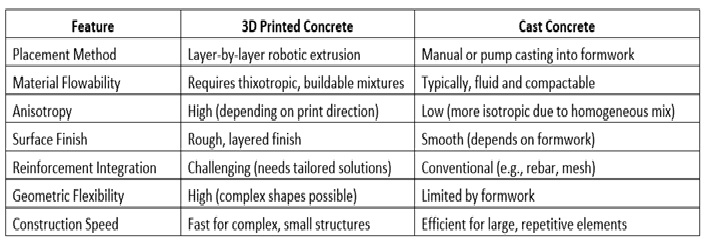Bridging 3D-Printed and Cast Concrete: A Review of Mechanical Bond Behavior, Composite Action, and Sustainable Protective Structures

DOI:
https://doi.org/10.54060/a2zjournals.jmce.78Keywords:
3D Printed Concrete, Cast-in-Place Concrete, Interfacial Bond Behavior, Digital ConstructionAbstract
New possibilities in digital construction are made possible by the combination of 3D printed concrete with traditional cast concrete, which allows for the quick fabrication of hybrid structures that blend structural efficiency, customization, and geometric intricacy. The mechanical bond behavior and composite action at the interface between cast concrete and 3D printed concrete, however, continue to be significant obstacles influencing the overall performance, longevity, and structural integrity of such hybrid systems. In order to clarify the interfacial mechanisms driving load transmission, failure modes, and bond strength development, this thorough study examines current developments in experimental techniques and numerical modelling approaches. Additionally, the research examines how printing parameters, interface preparation methods, and reinforcing tactics can improve composite activity. At the same time, the assessment assesses the application and design of 3D printed concrete for protective constructions, such as—including blast-resistant barriers, disaster shelters, and impact-absorbing walls—highlighting their performance under extreme loading conditions. Through a comparative analysis of existing findings, we identify research gaps, standardization needs, and future directions for optimizing mechanical synergy in hybrid 3D printing systems. Visual summaries including comparative tables, bond stress–slip relationship charts, and schematic illustrations of interface mechanisms are provided to facilitate deeper understanding. This review contributes to the foundation for the next generation of high-performance, sustainable, and rapidly deployable concrete structures.
Downloads
References
B. Nan, Y. Qiao, J. Leng, and Y. Bai, “Advancing structural reinforcement in 3D-printed concrete: Current methods, challenges, and innovations,” Materials (Basel), vol. 18, no. 2, 2025; https://doi.org/10.3390/ma18020252
J. Chen, “Review of 3D Printed Concrete: Mix Design,” Applied and Computational Engineering, vol. 127, pp. 24–29, 2025. https://doi.org/10.54254/2755-2721/2025.20060
L. Wang, Y. Yang, Y. Hu, and G. Ma, “Interfacial Properties of Three-Dimensional-Printed Permanent Formwork with Cast-in-Place Concrete. 3D Print Addit Manuf,” vol. 11, pp. 60–67, 2024. doi: 10.1089/3dp.2021.0213
B. Zareiyan and B. Khoshnevis, “Effects of interlocking on interlayer adhesion and strength of structures in 3D printing of concrete,” Autom. Constr., vol. 83, pp. 212–221, 2017. https://doi.org/10.1016/j.autcon.2017.08.019
D. Y. W. Tay, A. G. H. Ting, B. Panda, L. He, and M. J. Tan, “Bond strength of 3D printed concrete,” in Proceedings of the 3rd International Conference on Progress in Additive Manufacturing, pp. 25–30, 2018. https://doi.org/10.25341/D4T59C
B. Panda, S. C. Paul, N. A. N. Mohamed, Y. W. D. Tay, and M. J. Tan, “Measurement of tensile bond strength of 3D printed geopolymer mortar,” Measurement (Lond.), vol. 113, pp. 108–116, 2018. https://doi.org/10.1007/978-3-319-99519-9_18
R. J. M. Wolfs, F. P. Bos, and T. A. M. Salet, “Hardened properties of 3D printed concrete: The influence of process parameters on interlayer adhesion,” Cem. Concr. Res., vol. 119, pp. 132–140, 2019. https://doi.org/10.1016/j.cemconres.2019.02.011
Y. W. D. Tay, B. Panda, S. C. Paul, N. A. Noor Mohamed, M. J. Tan, and K. F. Leong, “3D printing trends in building and construction industry: a review,” Virtual Phys. Prototyp., vol. 12, no. 3, pp. 261–276, 2017. https://doi.org/10.1080/17452759.2017.1326724
L. He, H. Li, W. T. Chow, B. Zeng, and Y. Qian, “Increasing the interlayer strength of 3D printed concrete with tooth-like interface: An experimental and theoretical investigation,” Mater. Des., vol. 223, no. 111117, p. 111117, 2022. https://doi.org/10.1016/j.matdes.2022.111117
Y. Zhang, L. Yang, R. Qian, G. Liu, Y. Zhang, and H. Du, “Interlayer adhesion of 3D printed concrete: Influence of layer stacked vertically,” Constr. Build. Mater., vol. 399, no. 132424, p. 132424, 2023. https://doi.org/10.1016/j.conbuildmat.2021.126256
M. Ahmed, Y. W. D. Tay, B. Panda, M. J. Tan, and S. C. Paul, “Interfacial bonding per-formance of 3D-printed Ultra-High Performance Strain-Hardening Cementitious Composites (UHP-SHCC) and cast normal concrete,” Journal of Building Engineering, vol. 82, 2023. https://doi.org/10.1016/j.jobe.2023.108268
F. Bos, R. Wolfs, Z. Ahmed, and T. Salet, “Additive manufacturing of concrete in construction: potentials and challenges of 3D concrete printing,” Virtual Phys. Prototyp., vol. 11, no. 3, pp. 209–225, 2016. https://doi.org/10.1080/17452759.2016.1209867
Y. Zhang, L. Yang, R. Qian, G. Liu, Y. Zhang, and H. Du, “Interlayer adhesion of 3D printed concrete: Influence of layer stacked vertically,” Constr. Build. Mater., vol. 399, p. 132424, 2023. https://doi.org/10.1016/j.conbuildmat.2023.132424
M. Hambach, et al. "Reinforcement of 3D printed concrete structures with micro and macro fibers." Materials, vol. 9, no. 7, p. 535, 2016. [DOI: 10.3390/ma9070535]
R. J. M. Wolfs, et al. "Structural capacity of 3D printed reinforced concrete beams." Engineering Structures, vol. 198, p. 109342, 2019. [DOI: 10.1016/j.engstruct.2019.109342]
T. Marchment, “Understanding the fracture behavior of additively manufactured concrete,” Cement and Concrete Research, vol. 137, 2020. [DOI: 10.1016/j.cemconres.2020.106211]
R. J. M. Wolfs, F. P. Bos, and T. A. M. Salet, “Hardened properties of 3D printed concrete: The influence of process parameters on interlayer adhesion,” Cem. Concr. Res., vol. 119, pp. 132–140, 2019. https://doi.org/10.1016/j.cemconres.2019.02.011
L. Wang, D. Zhang, and G. Ma, “Finite element modeling of mechanical behavior of 3D printed concrete considering interlayer interfaces,” Construction and Building Materials, vol. 270, 2021.https://doi.org/10.1016/j.conbuildmat.2020.121430
B. Panda, Y. W. D. Tay, S. C. Paul, and M. J. Tan, “Coupled hygro-mechanical modeling of early-age behavior of 3D printed concrete layers,” Journal of Building Engineering, vol. 72, p. 106659, 2023. https://doi.org/10.1016/j.jobe.2023.106659
B. Panda, S. C. Paul, N. A. N. Mohamed, Y. W. D. Tay, and M. J. Tan, “Measurement of tensile bond strength of 3D printed geopolymer mortar,” Measurement (Lond.), vol. 113, pp. 108–116, 2018. https://doi.org/10.1016/j.measurement.2017.08.051
B. Panda, “Bond strength of 3D printed concrete interfaces: Experimental insights,” Construction and Building Materials, vol. 163, pp. 318–331, 2018. [DOI: 10.1016/j.conbuildmat.2017.12.136]
T. T. Le, S. A. Austin, S. Lim, R. A. Buswell, A. G. F. Gibb, and T. Thorpe, “Mix design and fresh properties for high-performance printing concrete,” Mater. Struct., vol. 45, no. 8, pp. 1221–1232, 2012. https://doi.org/10.1617/s11527-012-9828-z
N. Roussel, “Rheological requirements for printable concretes,” Cem. Concr. Res., vol. 112, pp. 76–85, 2018. https://doi.org/10.1016/j.cemconres.2018.05.004
A. Perrot, D. Rangeard, and A. Pierre, “Structural built-up of cement-based materials used for 3D-printing extrusion techniques,” Mater. Struct., vol. 49, no. 4, pp. 1213–1220, 2016.
https://doi.org/10.1617/s11527-015-0571-0
T. T. Nguyen, T. D. Le, and V. T. Tran, “Experimental and numerical study on the flexural behavior of 3D-printed composite beams with U-shaped ECC formwork,” Engineering Structures, vol. 263, p. 114383, 2022. https://doi.org/10.1016/j.engstruct.2022.114383
Y. Guo, Y. Wang, and Y. Zhang, “Interfacial bond in concrete-to-concrete composites: A review,” Construction and Building Materials, vol. 348, p. 128621, 2022. https://doi.org/10.1016/j.conbuildmat.2022.128621
M. M. Alrubaye, R. Al-Mahaidi, and R. Al-Mahaidi, “Experimental evaluation of bond strength performance between different concrete interfaces,” Journal of Engineering Science and Technology, vol. 15, no. 6, pp. 4370–4384, 2020.
https://jestec.taylors.edu.my/Vol%2015%20issue%206%20December%202020/15_6_57.pdf
Z.-F. Zhou, Z.-H. Pu, and J.-H. Tang, “Application of bilinear cohesive zone model in damage and cracking analysis of concrete pavement,” Journal of Traffic and Transportation Engineering, vol. 19, no. 1, pp. 17–23, 2019.https://doi.org/10.19818/j.cnki.1671-1637.2019.01.003
F. Mu and J. Vandenbossche, “A superimposed cohesive zone model for investigating the fracture properties of concrete-asphalt interface debonding: A Superimposed Cohesive Zone Model for Investigating Interface Debonding,” Fatigue Fract. Eng. Mater. Struct., vol. 40, no. 4, pp. 496–511, 2017.
https://doi.org/10.1111/ffe.12509
W. Zhang, Z. Tang, Y. Yang, and J. Wei, “Assessment of FRP–concrete interfacial debonding with coupled mixed-mode cohesive zone model,” J. Compos. Constr., vol. 25, no. 2, p. 04021002, 2021.
https://doi.org/10.1061/(ASCE)CC.1943-5614.0001114
L. M. Mauludin, C. Oucif, and T. Rabczuk, “The effects of mismatch fracture properties in encapsulation-based self-healing concrete using cohesive-zone model,” Front. Struct. Civ. Eng., vol. 14, no. 3, pp. 792–801, 2020.
https://doi.org/10.1007/s11709-020-0629-0
T. Paulay and M. J. N. Priestley, Seismic Design of Reinforced Concrete and Masonry Buildings. John Wiley & Sons, 2022.https://doi.org/10.1002/9780470172841
L. Wang, Y. Liu, Y. Yang, Y. Li, and M. Bai, “Bonding performance of 3D printing concrete with self-locking interfaces exposed to compression–shear and compression–splitting stresses,” Addit. Manuf., vol. 42, p. 101992, 2021.

Downloads
Published
How to Cite
CITATION COUNT
Issue
Section
License
Copyright (c) 2025 Girmay Mengesha Azanaw

This work is licensed under a Creative Commons Attribution 4.0 International License.
























